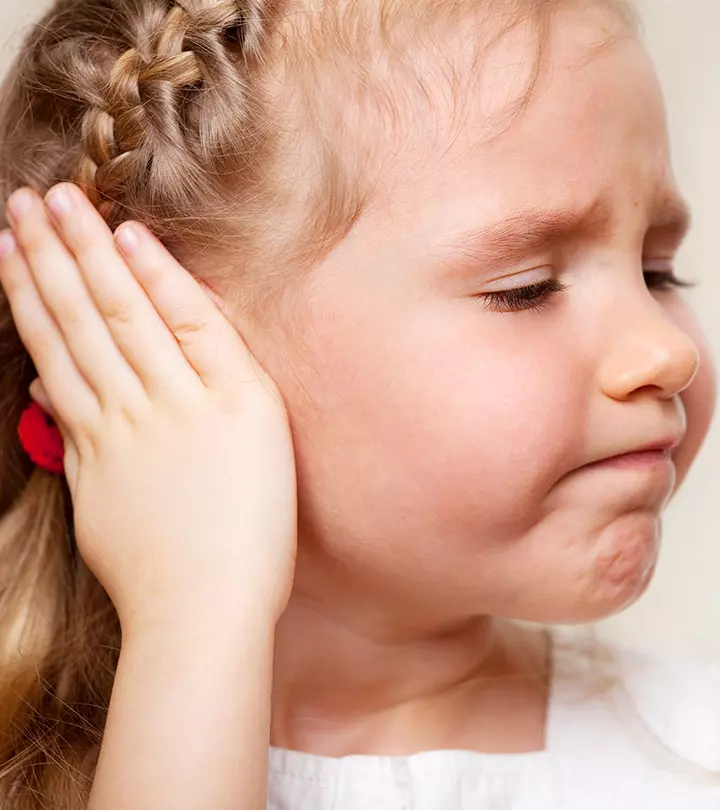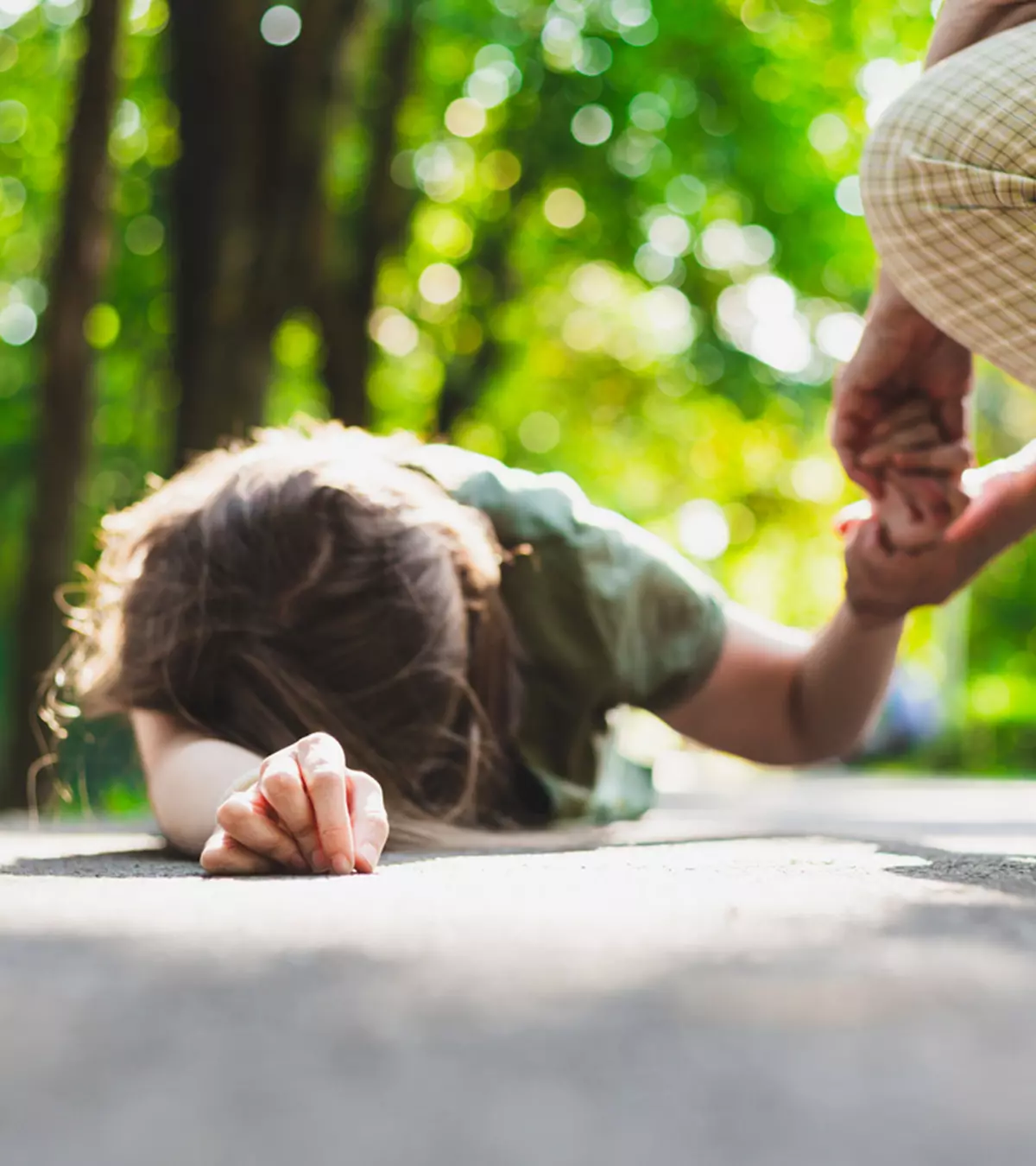
Image: Shutterstock
Brain gym exercises for kids are an excellent way of developing the cognitiveiThe brain’s ability to acquire, process, store, and retrieve information. and intellectual skills of a child, while also enhancing their mental agility. Brain training exercises may also make the child smarter, aiding their overall growth and development, which may differ for every kid.
These exercises also provide an opportunity to improve your child’s cognitive skills, enhance brain function, and display different learning strategies. It may eventually make children brighter, sharper, and more confident than their peers.
This post discusses some fun brain gym activities for children that you may do with your child.
Key Pointers
- Brain gym exercises can enhance a child’s cognitive and intellectual skills, brain function, and confidence levels.
- These exercises promote a child’s attention, muscular and mental coordination, physiological stability, self-expression, and memory.
- Brain exercises, such as lazy eights, double doodle, the elephant, active arm, earth buttons, hookups, and thinking cap can boost skills such as vision, hearing, alertness, learning, and critical thinking.
- Brain exercises, including the cross crawls, the owl, and the gravitational glider encourage lateral movement and help improve blood circulation and oxygen flow.
Best Brain Gym Exercises
Here are some brain exercises you can try with children at school, at home, in teams, solo, or even during playtime. Despite the name suggesting exercises that can help children’s cognitive development, these exercises are also suitable for improving physical health and overall development.
1. Cross Crawls
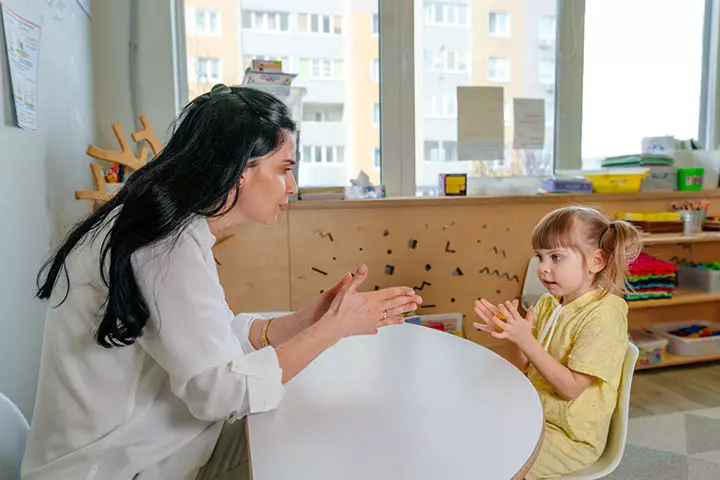
Image: IStock
- The exercise helps release excess stress in kids with the possibility of concentration improvement, resulting in an effective focus on studies.
- Instruct your child to move his left arm to the right leg and switch sides.
- The slow lateral movement enhances the attention span of your child and mental coordination.
2. Lazy Eights
- Instruct your child to draw the figure eight multiple times, either an imaginary one in the air or on a piece of paper.
- The exercise activates your kid’s creative side and loosens the muscles of his arm and wrist.
- The exercise helps improve your kid’s reading speed, eye-muscle coordination, and peripheral visioiThe ability to see objects from the corner of your eyes. n.
 Quick fact
Quick fact3. Double Doodle
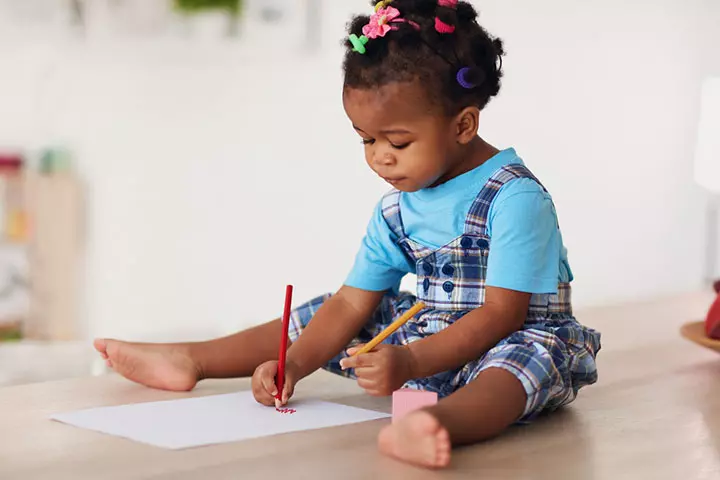
Image: Shutterstock
- This bilateral drawing activity requires your kid to sketch two images with both his hands.
- The activity encourages your kid’s learning skills and improves spelling accuracy, math calculation speed, and recognition of writing symbols. This is a great brain gym activity for kids.
4. The Elephant
- Instruct your child to stretch one of his hands and place it near the same-sided ear.
- By rotating the extended hand, he needs to make the symbol infinity in the air at least three times, and vice versa.
- The movements activate your kid’s mind and body balance and encourage the brain to listen to the words correctly.
- It improves your kid’s thinking ability, increases the ability to pay attention to detail, and is great as a short- and long-term memory booster.
5. The Owl
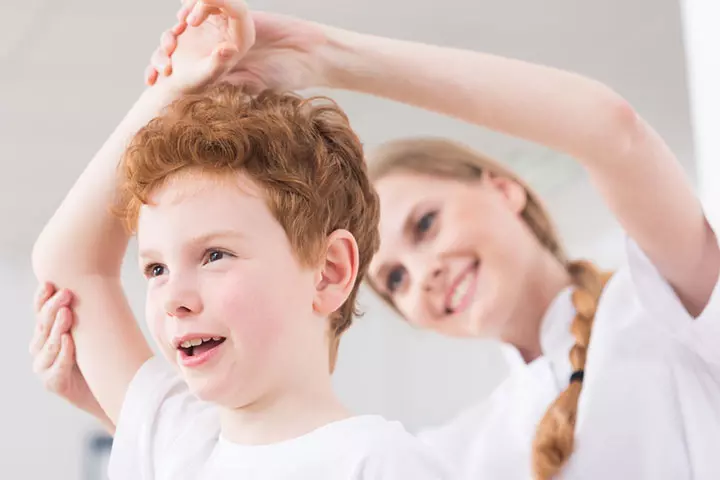
Image: Shutterstock
- Ask your child to sit comfortably and bring one of his hands to the opposite shoulder.
- By holding the hand steady, he has to pinch the shoulder around the trapezius muscleiA large, flat muscle that runs across the shoulders and down the upper back. .
- Your kid should now turn his head towards the direction of the pinched shoulder and take a deep breath.
- The exercising posture and range of motion improves the blood circulation and improves your child’s attention and memory.
6. The Active Arm
- Have your child stretch one of his arms and the other arm should be held at a right angle to hold the extended arm in a firm position.
- The exercise strengthens your kid’s upper chest and shoulders.
- It activates your kid’s brain, betters hand-eye coordination, and tool controlling skills.
 Research finds
Research finds7. The Gravitational Glider
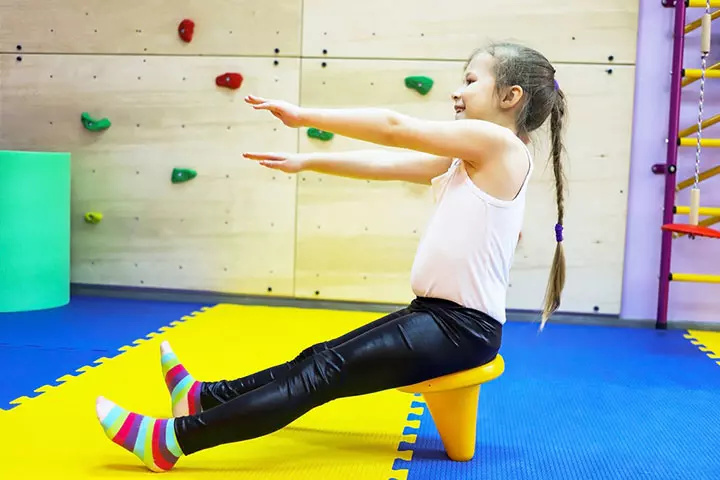
Image: Shutterstock
- While sitting straight on a chair, your child must stretch his legs and cross the right leg over the left at the ankles.
- Taking a deep breath, he should now lean forwards and stretch the arm to reach up to the feet.
- The gravitational glider stretches your kid’s hamstringiA trio of muscles at the back of the thighs that go from the hip to slightly below the knee. and enhances blood and oxygen flow.
- The exercise boosts your child’s self-expression, confidence, and stability..
8. Earth Buttons
- Instruct your child to either stand or sit down comfortably.
- He should place the right hand on the lips and the palm of the left hand over the navel position.
- Now he needs to rub both the upper and lower body parts in a small, circular motion.
- The earth buttons exercise helps improve mental alertness and whole-body orientation.
9. The Thinking Cap

Image: IStock
- Your child has to hold both the ears with his thumbs and the index fingers of both hands and roll and unroll the outer edge of the ear.
- Thinking Cap helps to improve hearing, peripheral vision, and short-term memory.
10. Hook-ups
- Your child can either perform the exercise while standing, sitting, or lying down.
- Have him cross the left ankle over the right one, intertwine the fingers and place them near the chest and breathe deeply.
- This exercise promotes mind and body relaxation.
11. Calf Pumps
- To do the calf pump exercise, a child stands using a wall or chair for support, putting one leg behind and leaning forward with a bent knee.
- As they shift their weight to the front leg, the heel of the back leg goes up, and when the weight shifts back, the heel is pressed to the floor.
- The child breathes out during this, repeating the exercise three times.
- This action activates the brain for back-front integration, making speech and language skills better in children.
- The calf pump exercise helps fix the natural length of tendons in the feet and lower legs, which may shrink during times of fear.
Frequently Asked Questions
1. What age is brain gym for?
Brain gym in children may start at any age. It is primarily introduced in preschool and school children and may be started as young as one and a half years (1).
2. Is brain gym an effective educational intervention?
Brain gym is considered helpful in improving attention, memory, and academic skills but has not been unanimously accepted as an effective educational intervention. Sufficient scientific evidence is yet to be established in its favor (2) (3).
3. Is brain gym discredited?
Brain gym is considered a myth as there is no clear evidence (2) (4). The lack of adequate scientific data supporting the effectiveness of the techniques could be the reason.
4. Which brain gym technique should I use to calm children down?
Hook-Ups is one of the several brain gym methods used to calm children’s nervous systems and relax their bodies because these exercises link the body’s electrical circuits and help circulate energy that has been blocked by tension.
5. How can brain gyms be used in the classroom?
School management can make brain gyms a part of childrens’ warm up activities that children can perform before starting a lesson or activity. Alternatively, these activities can be used during breaks to help children get refreshed and re-energized.
6. What are brain exercises for children called?
Brain exercises or brain gym exercises are also called cognitive training that includes age-appropriate routine activities for children to enhance their cognitive abilities, such as attention, memory, and problem-solving skills.
Mind game exercises are a fun and creative way for cognitive development in children. These brain gym exercises for kids are suitable for enhancing their creative thinking and logical reasoning power. With this collection of children’s exercises, you can help them achieve better mental health by improving their executive functioning, memory, alertness, stability, and calmness. Remember not to push them too hard and let them complete the workout at their pace by making them understand the importance of each exercise.
Illustration: Top 11 Brain Gym Exercises For Kids
Brain gym exercises are simple exercises designed to improve concentration and cognitive functions in children. Incorporating these exercises into your child’s routine could positively impact their learning and development. So, check out the below infographic detailing these exercises and their potential benefits, and choose the most appropriate one for your child. Illustration: Momjunction Design Team
Illustration: Top 11 Brain Gym Exercises For Kids
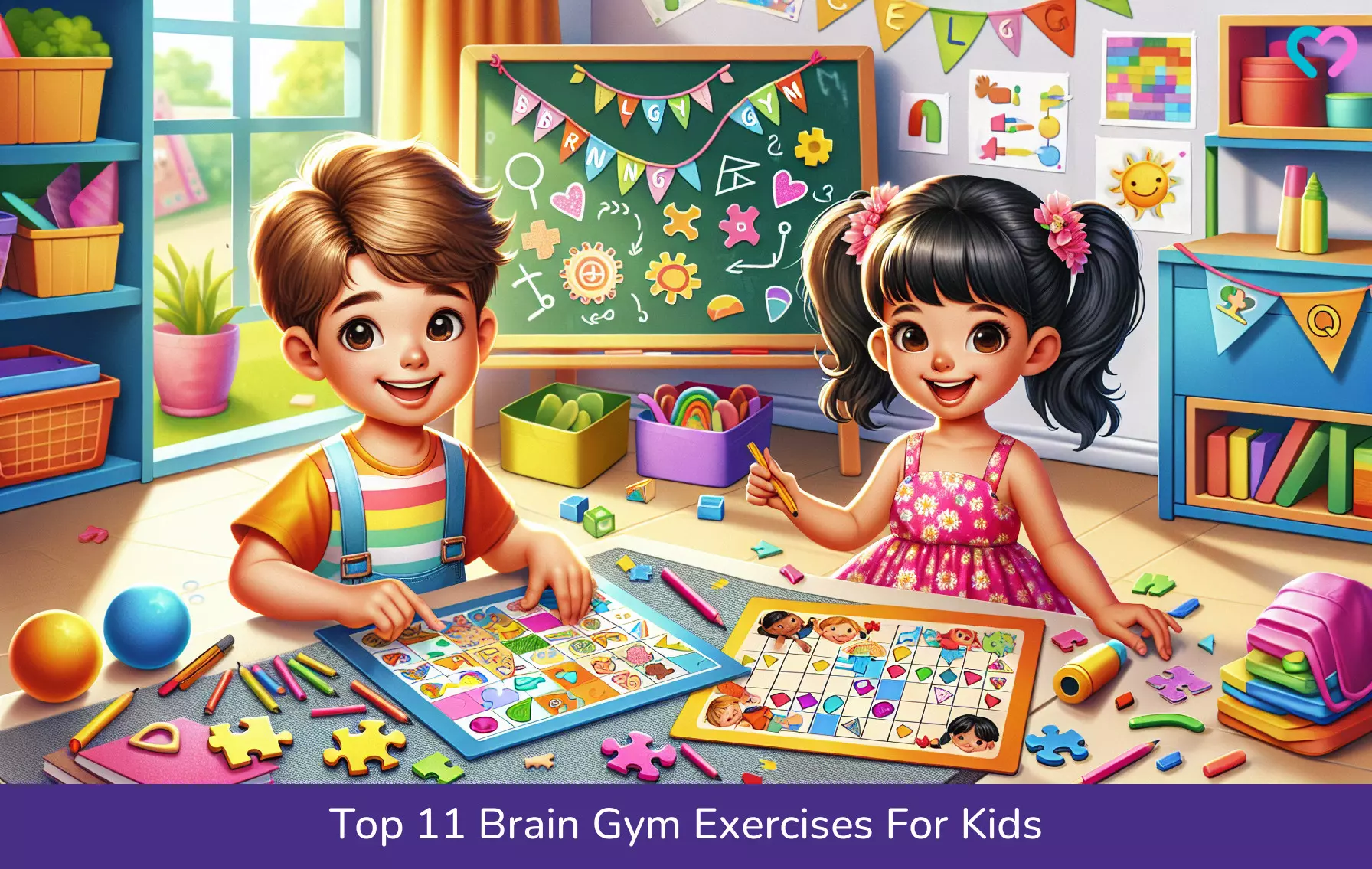
Image: Dalle E/MomJunction Design Team
Brain exercises are believed to improve one’s memory and concentration. Check out this interesting video below to understand how they may sharpen your mind and help in boosting your productivity.
References
- Brain Gym exercises for preschool and pre primary classes.
https://tattvaschool.edu.in/view-blogs?name=brain-gym-exercises-for-pre-schoolers-and-pre-primary-classes - Andrea Watson and Ginger L. Kelso; (2014); THE EFFECT OF BRAIN GYM® ON ACADEMIC ENGAGEMENT FOR CHILDREN WITH DEVELOPMENTAL DISABILITIES.
https://files.eric.ed.gov/fulltext/EJ1029010.pdf - Lucinda S. Spaulding et al.; (2010); Is Brain Gym an E ain Gym an Effective Educational Intervention?
https://digitalcommons.liberty.edu/cgi/viewcontent.cgi?referer=&httpsredir=1&article=1167&context=educ_fac_pubs - Myths and ineffective methods.
https://ebtn.org.uk/myths/ - Nikita H Seth et al.; (2022); Influence of Brain Gym Activities on Sleep Quality in Moderate Insomnia.
https://www.ncbi.nlm.nih.gov/pmc/articles/PMC9527040/ - Kristen Keinath et al.; (2005); The Effects of Brain Gym® Activities on Second-Grade Students’ Academic Performance and Handwriting Skills.
https://scholarworks.wmich.edu/cgi/viewcontent.cgi?article=4356&context=masters_theses
Community Experiences
Join the conversation and become a part of our nurturing community! Share your stories, experiences, and insights to connect with fellow parents.
Read full bio of Dr. Regina A. Hardin
Read full bio of Sagari Gongala
Read full bio of Swati Patwal
Read full bio of Trisha Chakraborty












